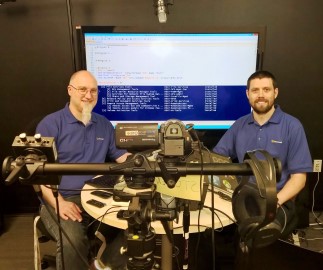17 Hours of PowerShell Desired State Configuration (DSC) Video Training
PowerShell DSC Video Training now available!
I am excited! Microsoft Premier customers now have access to 17 hours of real-world PowerShell Desired State Configuration (DSC) video training through the Premier Workshop Library on Demand (WLOD) subscription. We recorded 11 modules on topics from beginner to advanced. The training gracefully builds one concept upon another until the student is armed with all of the information they need to successfully begin using PowerShell DSC in their environment.
We wrote this training after spending months in the field helping customers just like you get started with PowerShell DSC. We took that experience and wrapped it into this video training for the real-world knowledge that our customers love.
Microsoft Premier Workshop Library on Demand
 You can get full-length, quality PowerShell training directly from Microsoft via streaming video at your convenience.
You can get full-length, quality PowerShell training directly from Microsoft via streaming video at your convenience.
As a Microsoft Premier Field Engineer I teach many PowerShell workshops. Traditionally this has been classroom work, but over the last few years we have expanded our online offerings. We teach live remote workshops over Lync and use cloud-hosted labs. We also record training videos for you to stream on your schedule.
We call the online training videos Education as a Service and have given it the brand name Premier Workshop Library on Demand. Check out a YouTube video explaining it here.
This photo is from the sessions with my peer, Ben Wilkinson, when we recorded Desired State Configuration With PowerShell v5.0 Video Series.
Content Outline
Here is an outline of the content covered in each module:
Module 1: Introduction. Get an overview of Windows PowerShell Desired State Configuration (DSC), the requirements, versions, terminology, and implementation considerations. Understand where this technology can assist in server deployment and configuration.
Module 2: Push. Begin working with MOF files and the Local Configuration Manager (LCM). Then learn how to write a configuration and push it to a target server. Finally, query the status of the server after configuration.
Module 3: Pull. Build a central server to host configurations. Configure target nodes (servers) to get their configuration from the central server. Verify configuration success remotely.
Module 4: Security. Understand the certificate requirements for securing DSC data. Encrypt configuration credentials at rest. Encrypt configuration data in transit. Compare security techniques against compliance requirements.
Module 5: Resources. Work with configuration resources that are both built-in and open source. Discover and use resources in the Microsoft DSC Resource Kit. Stage resources for node use via either push or pull.
Module 6: Custom Resources. Write resources for custom configuration scenarios. Use both script-based and class-based techniques. Learn how to manage reboots, test, and version custom resources. Understand best practices for designing and testing resources.
Module 7: Troubleshooting. Configure the LCM to assist in troubleshooting scenarios. Enable and use the DSC event logs for researching issues. Leverage the xDscDiagnostics module to trace configurations on remote nodes.
Module 8: Advanced Configurations. Use PowerShell scripting to automate configuration creation. Scale configurations for multiple nodes and multiple role configurations using ConfigurationData. Abstract configuration resources using Composite Configurations.
Module 9: Advanced LCM Scenarios. Configure a node with configuration data from multiple sources. Build multi-node configuration scenarios with cross-node dependencies. Compare configurations across multiple nodes for analysis and reporting.
Module 10: Reporting. Use the built-in DSC reporting web service to report on desired state details of nodes. Configure nodes for central reporting. Integrate DSC status into other enterprise monitoring tools.
Module 11: Azure. Deploy and configure virtual machines directly in Azure using the Azure DSC Extension. Apply configurations to existing Azure virtual machines. Automate dev/test scenarios.
How do I get it?
The course title is Desired State Configuration With PowerShell v5.0 Video Series. Only Microsoft Premier customers can subscribe to this offering; talk to your Premier Technical Account Manager (TAM) for more information. If you would like to become a Premier customer go here.
Enjoy!
Comments
- Anonymous
May 25, 2015
I'm part of a Microsoft Gold partner... they have no idea how to access this. I work for a massive corporation with an unlimited Microsoft license... they have no idea how to access this.
I suppose this is another tier for Microsoft to sell to but as is often the case it's inaccessible to the people who could use it. - Anonymous
May 25, 2015
What is Cody talking about? Why limit this information to premier only? - Anonymous
May 28, 2015
208 Microsoft Team blogs searched, 50 blogs have new articles. 143 new articles found searching from - Anonymous
June 10, 2015
The comment has been removed - Anonymous
June 11, 2015
The comment has been removed - Anonymous
June 29, 2015
The Goatee PFE (Premier Field Engineer) is a resource for the Premier organization and this offering is for customers with Premier support agreements in place. 98% of Enterprise customer have a Premier support agreement. Please talk to your Microsoft Technical Account Manager for more information, or your internal Microsoft rep for more information. - Anonymous
September 08, 2015
These are some helpful links for folks new to PowerShell and Desired State Configuration. - Anonymous
September 11, 2015
Cody,
Here's a series of free DSC videos on Microsoft's Virtual Academy.
Getting Started with PowerShell Desired State Configuration (DSC)
https://channel9.msdn.com/Series/Getting-Started-with-PowerShell-Desired-State-Configuration-DSC - Anonymous
September 15, 2015
Clickbait...should have mentioned premier in the tweet - Anonymous
February 25, 2016
how can microsoft FTE access this training?